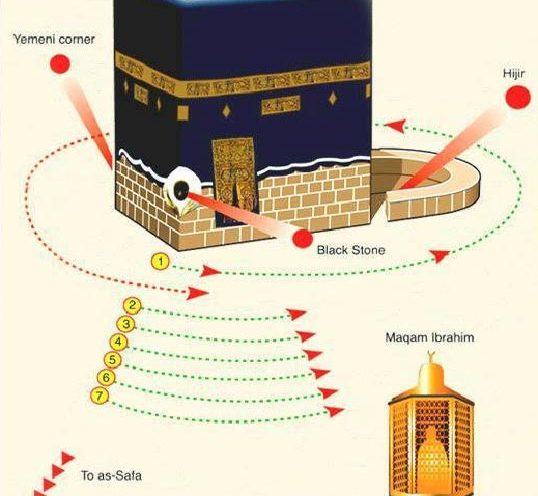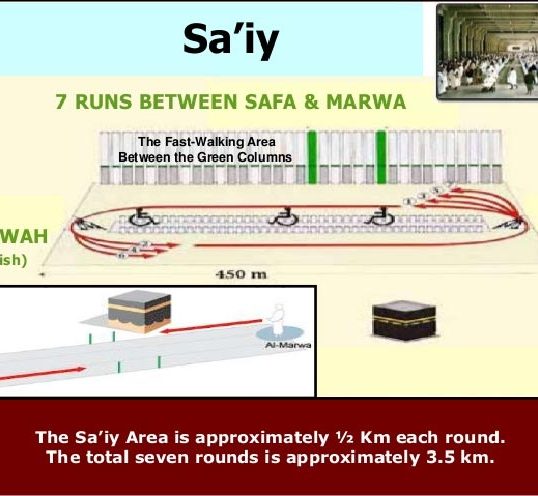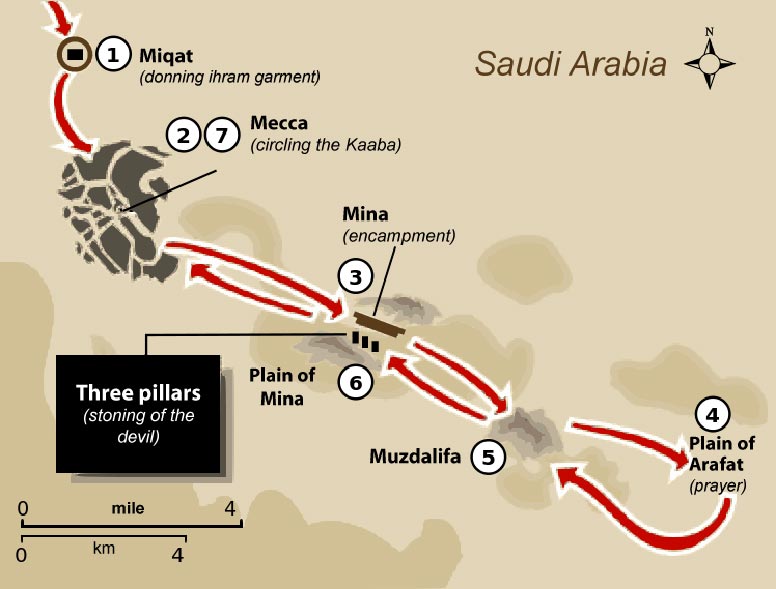- Make Ghusl
- Enter the state of Ihram (those doing Qiran and Ifrad are already in Ihram). For Tamattu put on Ihram again in Makkah.
- Perform 2 rakah nafl salah for Ihram.
- Make Niyyah for Hajj, read “Talbiyah” and keep reading as much as possible.
- Leave Makkah for Mina reaching there preferably before Dhuhr
- Stay in Mina, perform Dhuhr, ‘Asr, Maghrib and ‘Isha Salah.
Different types of Hajj
IFRAAD (Single)
To perform Hajj only, during the days of Hajj and to wear Ihram solely for Hajj.
With the completion of the Hajj, this form of Ihram comes to an end. The one who performs Ifraad is called Mufrid.
QIRAN (Combined)
This is known as the continuous Hajj. Meaning, to perform Umrah first, in the months of Hajj, (Shawwal, Dhul Qa’dah and the first eight days of Dhul Hajj) and thereafter to perform Hajj in the continued state of Ihram for both Hajj and Umrah. The one who performs Qiran is called Qaarin.
TAMATTU (Interrupted)
This is known as the interrupted Hajj. Meaning, to perform Umrah during the months of Hajj and then release the Ihram. Thereafter to put the Ihram back on (on the 8th of Dhul Hajj) and to perform Hajj the same year without leaving the Meeqat. The one who performs Tamattu is called Mutamatti.
DAY 1
8th of Dhul Hijjah
DAY 2
9th of Dhul Hijjah – The day of ‘Arafah
- Perform Fajr prayer in Mina.
- After sunrise proceed to Arafat.
- Keep reading “Labbaik”
- Engage in worship and stand in Du’a as much as possible during your stay in Arafah.
- Offer Dhuhr and Asr prayer. Do not combine them.
- Leave Arafah after sunset, without offering Maghrib prayer. You will pray this in Muzdalifah.
- On the way to Muzdalifah recite Labbaik and Durud
- Offer combined Maghrib and ‘Isha prayer in Muzdalifah at the time of ‘Isha.
- Spend the night partly in rest and partly in prayer and devotion.
- Collect approximately 70 small pebbles for Rami.
DAY 3
10th of Dhul Hijjah –The day of Eid
- Perform Fajr prayer in Muzdalifah.
- Leave for Mina just before sunrise.
- On the way recite Labbaik and Durud
RAMI - STONING
- Stone the Largest pillar of shaytaan (closest to Makkah) with 7 stones.
- Keep Mina on right and Makkah on left.
- Stop reciting the Labbaik with the throwing of the first pebble.
- Time for stoning is between the Fajr of the 10th until the the Fajr of 11th Dhul Hijjah. Recommended time for stoning is from Sunrise to Zawaal.
QURBANI - SACRIFICE 2
- Sacrifice an Animal (Qurbani)
- Shave or trim your hair (women should cut about an inch). It is necessary for the hair to be cut after the sacrifice.
- The Qurbani and hair cut should be within the boundaries of the Haram.
- Remove Ihram and wear normal clothes.
- Go to Makkah Mukarramah.
- Perform Tawaf-e-Ziyaarah (and Sa’ee if it was not done previously).
- Perform 2 raka’at after.
- Return to Mina and spend the night there.
- It is recommended to spend the nights of 11th,
DAY 4
11th of Dhul Hijjah
- Stay in Mina.
- Stone the 3 pillars starting with the smallest. After stoning the 1st and 2nd pillar make Du’a. After stoning the 3rd don’t wait for Du’a but return and make Du’a on the way back.
DAY 5
12th of Dhul Hijjah
- Stay in Mina, spending the time in regular and optional prayers and Du’a.
- Stone the 3 pillars same as mentioned above.
- Return to Makkah before sunset.
- If staying at Mina, repeat the same procedure of stoning the pillars on the 13th of Dhul Hijjah and then return to Makkah.
FAREWELL TAWAAF (Tawaaful Wadaa’)
- Perform Farewell Tawaaf with 2 Rak’ats.
- Not compulsory upon menstruating women.
HAJJ IS NOW COMPLETE
The Rituals of Hajj
Putting on Ihram
Going around the Ka’bah seven times (Tawaf)
Drinking Zamzam water.
A walk of seven courses between Safa and Marwa (Sa’ee)
Visiting and staying in Mina, Arafah and Muzdalifah
Throwing pebbles at three fixed symbolic pillars that represent the temptations of Satan.
Shaving or trimming the hair
Sacrifice of an animal (Sheep, Goat, Cow or Camel)
Restrictions While in the State of Ihram
- Use Perfume……… To help forget enjoyment of ordinary life.
- Kill or harm animals, even insects……… To feel that everything belongs to Allah
- Break or uproot plants…….. To kill one’s urge for aggression.
- Hunt……… To develop mercy.
- Marry or take part in a wedding……… To forget normal life and think of the creator.
- Do anything dishonest or arrogant……… To behave like a servant of Allah.
- Carry arms……… To give up violent attitudes.
- Cover the head (males)……… To express humility
- Cover the face (females)……… To express chastity and feel purity.
- Wear shoes covering the ankles…. To express simplicity.
- Cut hair or clip nails……… To express non-interference with Nature.
- Have conjugal relations……… To forget worldly pleasure.
TAWAAF

SA'EE

MAP OF THE HAJ RITES

This guide is a basic outline of the different aspects of hajj. For a full detailed version please refer to the book “A step by Step guide to Hajj, Umrah & Ziyarat”

